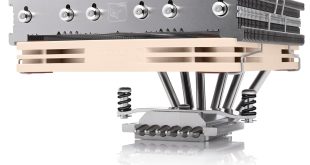All of the aesthetic options are great to look at, but we need to ascertain if the cooler can actually live up to performance claims as well. For this we are using a Core i7 970 processor which Intel supplied and we are testing it at reference clock speeds and voltages, and then cranking it to 4.33ghz with a 0.19 core voltage increase.
A few people have asked recently how I get such great overclocks with the CPU's I have, but I really have no answer, apart from having 25 years experience. I have seen some reviewers struggle with overclocking and I can only put it down to inexperience, poor mounting or bad component selection.
This 970 actually hits 4.65 ghz, but the voltage required could destroy it so we like to keep it reasonably sensible.
As many sites are claiming the Core i7 970 won't go higher than 4.1ghz regardless of voltage I felt a little validation was in order. Disbelievers can check it out over here: http://valid.canardpc.com/show_oc.php?id=1358577.
This combination of reference and overclocked performance will ensure that people can judge the end results and whether it will suit their specific demands. We are also including other coolers which we have tested in the past, such as the Thermaltake Frio, Corsair A70 and Noctua NH D14.
Idle temperatures are measured after 30 minutes resting in Windows and room temperature is maintained at 23c throughout, a comfortable real world environment for most people. We don't believe in testing coolers on an ‘open bench' as people at home won't be throwing parts onto a desk for everyday use.
We measured temperatures with diodes as motherboard readings can often be considerably wrong.
Coolit Vantage ALC
Comparison Coolers:
Noctua NH D14
Thermaltake Frio
Thermaltake Contac29
Coolit ECO ALC
Coolink Corator DS
Corsair A70 Cooler
Thermalright TRUE Revision C
Intel Reference Heatsink
Processor: Intel Core i7 970 CPU
Motherboard: MSI X58A-GD65
Memory: Crucial 6GB (3x2GB) 1600mhz DDR3
Graphics Card: Evga 1GB GTX460
Power Supply: Corsair AX850
Hard Drive: OCZ Agility 2
Chassis: Lian Li PC-8FIB
At reference clock speeds and voltages it is difficult to seperate the coolers, so we need to apply a 1.13 ghz clock increase by increasing the core voltage by 0.19. This should show greater variables. We used ‘extreme' setting on the Vantage here as there was no difference between the three – the processor wasn't generating enough heat to increase fan speeds.
We had to remove the Intel heatsink from the equation as the system would crash.
The Vantage ALC on extreme settings at these core voltages is achieving 69c under load, 1c better than the Frio and 3c higher (worse) than the NH D14 with 2 fans. The Vantage wasn't actually generating too much noise.
For our final test we will put the Noctua NH D14, Vantage and Frio in a head to head, after raising core voltage by 0.22 and increasing core speeds to 4.44ghz. Memory has risen to over 1800mhz at these settings (we know its fine to 2ghz with previous testing). Do you still believe the 970 I7 won't push past 4.1ghz?
Again CPU validation can be seen here http://valid.canardpc.com/show_oc.php?id=1358646. This is a sweet spot for the CPU as if we want to take it to 4.6ghz the core voltage needs raised by 0.28 which is a little high by our estimations.
The Vantage fans ramped up with these settings although we still found it bearable, but clearly audible. To be fair, these are the kind of settings you normally associate with high end watercooling solutions – such as those seen in the Cryo Nemesis pc we reviewed last month.
 KitGuru KitGuru.net – Tech News | Hardware News | Hardware Reviews | IOS | Mobile | Gaming | Graphics Cards
KitGuru KitGuru.net – Tech News | Hardware News | Hardware Reviews | IOS | Mobile | Gaming | Graphics Cards









